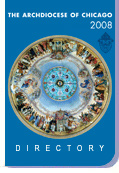 |
 |
|||||
 |
 |
 |
 |
 |
||
|
.
Nov. 12, 2006 A puppy in the family By Michelle Martin When Polly jumped up and put her paws on the counter, nosing at the leftover chicken from dinner, I snarled “No!” in my loudest voice as I scooped a hand under her belly and moved her several feet away. “Mom,” Frank said, “Stop. You’ll scare her.” “But I want to scare her,” I explained. “I want her to remember not to jump on the counter.” “But that’s mean,” Frank said. “Polly loves you.” I have no doubt that she does. The newest member of the household, a year-old, white and tan mixed-breed puppy, is nothing but a walking, chewing, barking, jumping, wagging bundle of love. She has a perpetual tongue-lolling grin and floppy ears and the innocent look of the young: “Who me? I couldn’t do anything wrong. I’m too cute.” But of course, she can do things that she shouldn’t, things that are dangerous to her (trying to swallow chicken bones among them) or to the other members of the household (knocking down 5-year-old Frank by jumping up and greeting him a bit too enthusiastically). So it’s up to us—all of us—to help her learn what she can do and what she can’t. That’s not much different from the way parents raise children. It’s the nature of babies and toddlers to be entirely self-centered, to act on every impulse, to put their needs ahead of everyone else’s—not even to recognize that anyone else has needs, for that matter. A parent’s job is to help children move from there to maturity, to be able to care about others, control their behavior, put their own needs in perspective compared to those of others. Most often, it’s a long process of learning by example. But sometimes, it requires a loud, immediate correction (Don’t go in the street! No hitting!). Those loud yells get attention, but they can be scary. Sometimes I forget that. Frank reminded me—and showed me how much he has grown up already, thinking about how Polly would feel about getting scolded so loudly. Polly might not be a human, but she is a member of the household, and he showed he could love his (canine) neighbor as well as himself. Sometimes people recommend getting pets to teach children responsibility, about the care that goes into taking care of an animal, what with feeding, watering, grooming and walking them. My children are still young, and they haven’t shown enough responsibility to be in charge of the dog’s basic needs yet. But if having pets helps them learn to empathize with others, especially those smaller and weaker than they are, then it will be worth it. Not to mention, of course, all the laughter that the dog can bring into our lives. Martin is a Catholic New World staff writer. Contact her at [email protected]. Martin is a Catholic New World staff writer. Contact her at [email protected] |
||
